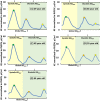Age- and sex-specific reference values of biventricular flow components and kinetic energy by 4D flow cardiovascular magnetic resonance in healthy subjects
- PMID: 37718441
- PMCID: PMC10506211
- DOI: 10.1186/s12968-023-00960-x
Age- and sex-specific reference values of biventricular flow components and kinetic energy by 4D flow cardiovascular magnetic resonance in healthy subjects
Abstract
Background: Advances in four-dimensional flow cardiovascular magnetic resonance (4D flow CMR) have allowed quantification of left ventricular (LV) and right ventricular (RV) blood flow. We aimed to (1) investigate age and sex differences of 4D flow CMR-derived LV and RV relative flow components and kinetic energy (KE) parameters indexed to end-diastolic volume (KEiEDV) in healthy subjects; and (2) assess the effects of age and sex on these parameters.
Methods: We performed 4D flow analysis in 163 healthy participants (42% female; mean age 43 ± 13 years) of a prospective registry study (NCT03217240) who were free of cardiovascular diseases. Relative flow components (direct flow, retained inflow, delayed ejection flow, residual volume) and multiple phasic KEiEDV (global, peak systolic, average systolic, average diastolic, peak E-wave, peak A-wave) for both LV and RV were analysed.
Results: Compared with men, women had lower median LV and RV residual volume, and LV peak and average systolic KEiEDV, and higher median values of RV direct flow, RV global KEiEDV, RV average diastolic KEiEDV, and RV peak E-wave KEiEDV. ANOVA analysis found there were no differences in flow components, peak and average systolic, average diastolic and global KEiEDV for both LV and RV across age groups. Peak A-wave KEiEDV increased significantly (r = 0.458 for LV and 0.341 for RV), whereas peak E-wave KEiEDV (r = - 0.355 for LV and - 0.318 for RV), and KEiEDV E/A ratio (r = - 0.475 for LV and - 0.504 for RV) decreased significantly, with age.
Conclusion: These data using state-of-the-art 4D flow CMR show that biventricular flow components and kinetic energy parameters vary significantly by age and sex. Age and sex trends should be considered in the interpretation of quantitative measures of biventricular flow. Clinical trial registration https://www.
Clinicaltrials: gov . Unique identifier: NCT03217240.
Keywords: 4D flow; Flow components; Hemodynamics; Kinetic energy; Reference values.
© 2023. Society for Cardiovascular Magnetic Resonance.
Conflict of interest statement
The authors declare that they have no competing interests.
Figures



Similar articles
-
Left ventricular flow kinetics and myocardial deformation following acute infarction: Additional predictive value of cardiac magnetic resonance four-dimensional flow for left ventricular remodeling post-ST-elevation myocardial infarction.J Cardiovasc Magn Reson. 2025 May 7;27(2):101905. doi: 10.1016/j.jocmr.2025.101905. Online ahead of print. J Cardiovasc Magn Reson. 2025. PMID: 40345668 Free PMC article.
-
Impact of age, sex and ethnicity on intra-cardiac flow components and left ventricular kinetic energy derived from 4D flow CMR.Int J Cardiol. 2021 Aug 1;336:105-112. doi: 10.1016/j.ijcard.2021.05.035. Epub 2021 May 25. Int J Cardiol. 2021. PMID: 34044022
-
Ventricular flow analysis and its association with exertional capacity in repaired tetralogy of Fallot: 4D flow cardiovascular magnetic resonance study.J Cardiovasc Magn Reson. 2022 Jan 3;24(1):4. doi: 10.1186/s12968-021-00832-2. J Cardiovasc Magn Reson. 2022. PMID: 34980199 Free PMC article.
-
Normal ranges of right ventricular systolic and diastolic strain measures in children: a systematic review and meta-analysis.J Am Soc Echocardiogr. 2014 May;27(5):549-60, e3. doi: 10.1016/j.echo.2014.01.015. Epub 2014 Feb 26. J Am Soc Echocardiogr. 2014. PMID: 24582163 Free PMC article.
-
Validating real-time three-dimensional echocardiography against cardiac magnetic resonance, for the determination of ventricular mass, volume and ejection fraction: a meta-analysis.Clin Res Cardiol. 2024 Mar;113(3):367-392. doi: 10.1007/s00392-023-02204-5. Epub 2023 Apr 20. Clin Res Cardiol. 2024. PMID: 37079054 Free PMC article.
Cited by
-
Right Ventricular Restrictive Physiology Is Associated With Right Ventricular Direct Flow From 4D Flow CMR.JACC Asia. 2024 Oct 22;4(12):912-924. doi: 10.1016/j.jacasi.2024.08.019. eCollection 2024 Dec. JACC Asia. 2024. PMID: 39802994 Free PMC article.
-
Non-Invasive Diagnosis of Chronic Myocardial Infarction via Composite In-Silico-Human Data Learning.Adv Sci (Weinh). 2025 Aug;12(30):e06933. doi: 10.1002/advs.202406933. Epub 2025 Jun 19. Adv Sci (Weinh). 2025. PMID: 40536227 Free PMC article.
-
Understanding Right Heart Flow: Implications for Interatrial Shunt Device Therapy in Heart Failure.J Soc Cardiovasc Angiogr Interv. 2025 Jan 21;4(1):102439. doi: 10.1016/j.jscai.2024.102439. eCollection 2025 Jan. J Soc Cardiovasc Angiogr Interv. 2025. PMID: 40061421 Free PMC article. Review.
-
Discordances in Kinetic Energy Between the Superior Cavopulmonary Connection and Single Ventricle Are Associated With Suboptimal Fontan Outcomes: A Pre-Fontan 4-Dimensional Flow Study.J Am Heart Assoc. 2025 Apr 15;14(8):e037949. doi: 10.1161/JAHA.124.037949. Epub 2025 Apr 3. J Am Heart Assoc. 2025. PMID: 40178094 Free PMC article.
-
Characteristics of altered biventricular hemodynamics after arterial switch operation for patients with d-transposition of the great arteries with preserved ejection fraction: a four-dimensional (4D) flow cardiovascular magnetic resonance (CMR) study.Quant Imaging Med Surg. 2024 Oct 1;14(10):7200-7217. doi: 10.21037/qims-24-840. Epub 2024 Sep 21. Quant Imaging Med Surg. 2024. PMID: 39429599 Free PMC article.
References
Publication types
MeSH terms
Associated data
LinkOut - more resources
Full Text Sources
Medical

